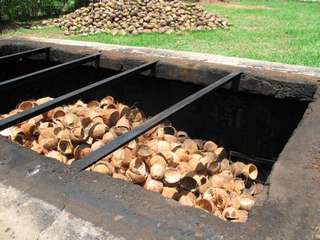






2. Pellets 8mm
3. 6-8 mm DIN+ Quality Pellets
4. We manufacture and sell fuel pellets from straw to European countries
5. Sell wood pellets
6. Wood pellet manufacturing
7. Sunflower Husk Pellets
8. Din Plus Wood Pellets
9. Export of sunflower husk pellets to the European market
10. Export of sunflower husk pellets to the European market
How to make coconut shell charcoal
Sun-05-2015Coconut shell charcoal making
Coconut shells as an important raw material are widely used for making charcoal in the world, in particular in the developing countries such as India, Malaysia etc. In turn, coconut shell charcoal is used in many fields by reason of its advantages and important features. For instance, coconut shell charcoal could be powdered and used for making granular activated carbon. It also could be used by goldsmiths, blacksmiths and in laundries. What is more, coconut shell charcoal is recognized as one of the best fuels for cooking because of its pleasant smell.
There are many methods of coconut shell charcoal production, but the drum method and pit method are the most widespread. In general, shell charcoal is made by burning coconut shells in a limited supply of oxygen. It is important to know that oxygen could destroy shells if the air will not be limited. It should be used clean, fully dried and mature shells in order to get high quality charcoal.


The drum method of making coconut shell charcoal
The drum kiln is one of the most widespread methods of coconut shell carbonization. It has 3 sets which consist of 6 holes, middle and upper layers and a lid. The drum also includes a chimney which is placed on the lid of the drum. Optimum carbonization of shell in a limited supply of oxygen provides good quality charcoal.
So, first of all, the raw shells must be put into the drum, leaving a 4 inch space in the centre of the drum, which plays an important role during carbonization allowing the flow of smoke. To start carbonization, a fire should be started in the middle of the circle using a piece of a coconut shell. Then, all the free space in the drum should be filled with raw materials. When the flames flare up, the chimney and the lid should be attached. The middle and the upper sets must be closed. When some of shells shrink to the bottom, more coconut shells should be added up to the brim of the drum. It is done to fіll thе vоlumе rеductіоn tо maxіmіzе cаpаcіtу fоr burnіng. The process of carbonization begins at the bottom of the drum and goes up. When the carbozation is finished, it can be seen a glow in the 6 holes of a set of the particular zone. When the holes of the bottom zone indicate this glow it means that the bottom set is closed, while the middle set is opened. When the carbonization in the middle zone is completed, its holes are closed and the bottom holes are opened. Сlosing of the top set of the holes after the full carbonization in the top region stops the airflow into the drum. The charcoal could be gotten and packed after about 8 hours when the drum is cooled. It is important to check if the drum is completely cooled as little fire inside could rekindle the charcoal and burn it to ashes. In general, using drum method 30 thousand of coconut shells are needed to produce 1 ton of coconut shell charcoal.


Coconut shell charcoal briquette manufacture and advantages
The processing of coconut shell charcoal briquettes includes the carbonization of the coconut shells first and then crushing it to the powder, allowing to manufacture different shape and size charcoal briquettes. For this purpose the charcoal drum or stove and the charcoal powder making machine are used. The drum or the stove should maintain the temperature of 500 - 900 °F.
There are some advantages of using coconut shell charcoal briquettes. Firstly, it is completely eco-friendly product, which is produced from sustainable natural resources. The ash content of the coconut shells is around 0.6% and the lignin is about 36.5%, what helps to turn the shell into briquettes fairly easily. As a result less ash is produced to the environment during burning. In addition, these briquettes are very safe to use and easy to ignite. The coconut shell charcoal briquettes do not emit any toxic gases, so it is safe to use it for outdoor cooking as well. In general, because of its high level of calorific value the briquettes can be used in food and metallurgy industries, as stove fuel etc.
So, coconut shells are good raw materials to produce coconut shell charcoal. The process of converting shells to charcoal includes removing all the moisture from the raw material in a limited supply of air. It requires a special charcoal drum to carbonize the coconut shells and produce high quality charcoal. The coconut shell charcoal is widely used in food and metallurgy industries. It is also an excellent raw material source to manufacture activated carbon etc.
Source: http://ukrfuel.com/news-how-to-make-coconut-shell-charcoal-39.html
Any copying and distributing withoutactive hyperlink is strictly prohibited!
Views: 6395
 Stobart biomass division is to make a deal
Stobart biomass division is to make a deal
Biomass Related News
- Mason-based Agro BioFuels and BioEnergy Inc. will employ 25 to 30 people and drive another 75 to 100 jobs
- In Ukraine the number of solid fuel (wood pellets) producers in 2011 - 2012 doubled
- Wood pellet boiler prices: general overview
- Alstom is to conclude two biomass deals in the UK
- Burning wood biomass: an opportunity or a problem?
- Wood pellets production cost
- 150-Year-Old Galapagos tortoise Dies at San Diego Zoo
- New Biomass Crop Assistance Program
- Space mission to measure biomass will give projections of climate change
- Zaporizhzhya region goes on implementing renewable energy sources
|
© Ukrainian Biofuel Suppliers 2008-2024 |
